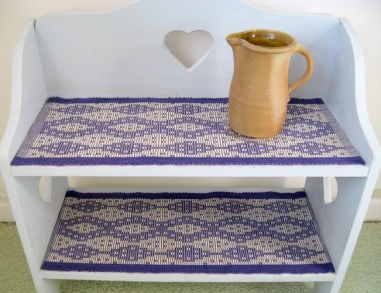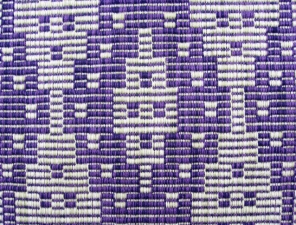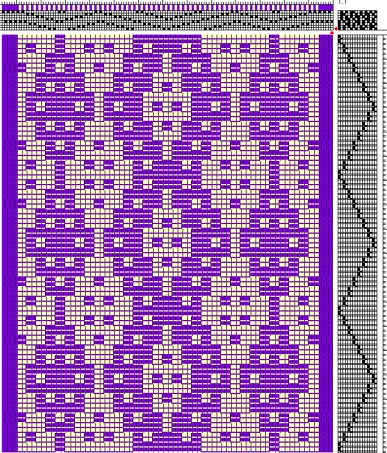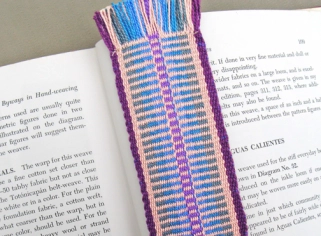While weaving a pair of warp rep (warp-faced rep weave) runners, I was already imagining weaving another one. So I did try a variation and a different color. Then I thought it would be interesting to weave another variation for a belt. That turned out to be a lot of fun. These are the projects that I will be writing about in this post.
I’m grateful to Rosalie Neilson whose articles about warp rep in Weaver’s magazine have taught me the basics and inspired me to develop my own designs. I list her articles and other references in a post about warp rep that I did some time ago. In this post, Rosalie’s article in Weaver’s #11, “Warp Rep: 8 Shafts, 8 Blocks,” is the one I used as a reference for my current projects, especially her warp rep sampler on pages 21-22.
For the pair of runners I used 20/2 cotton (2 strands together) in the warp, alternating purple and ecru, at 60 epi (6 per dent in a 10-dent reed), and for the weft I alternated a thick purple cotton with a thin 20/2 purple cotton:
I designed the draft for the purple runners by starting with threading and treadling pattern lines, and with the help of weaving software and what I learned from Rosalie’s article, I came up with this final draft:
In the above drafts, dark and light colors alternate in the threading (except in the borders which are one color), and thick and thin wefts alternate in the treadling. A complete thread-by-thread draft would be too lengthy, therefore this draft shows only 2 repeats of each 2-end threading block. I actually repeated each 2-end threading block 8 times for a total of 16 ends per block (except the borders which have a total of 32 ends on each side), while the 2 repeats of each 2-weft treadling block for a total of 4 weft shots per block worked out fine just as it is in the draft. I also used floating selvedges.
These are the 8 threading blocks on 8 shafts: (1,5), (2,6), (3,7), (4,8), (5,1), (6,2), (7,3), (8,4).
These are the 8 treadling blocks on 16 treadles: (1,2), (3,4), (5,6), (7,8), (9,10), (11,12), (13,14), (15,16).
Happy with the way the purple runners turned out, I was ready to weave another variation. I kept the same threading and treadling and played around with the tie-up until I came up with another pleasing pattern. I decided to use beautiful 5/2 pearl cotton, coral and ecru colors for the warp and a thick and thin cotton for the weft of colors similar to the border color. I resleyed the remaining warp on the loom to 40 epi, 4 per dent in the same 10-dent reed, and tied on my new pearl cotton warp. Here’s how it turned out:
The draft for the Coral Runner is exactly the same as for the Purple Runners except that the tie-up is different. Also, you may notice in the interlacement view of the draft below that some warp ends are side by side under the same wefts. In the draft, these dark and light colors appear to be in the right order, but during weaving they can shift positions and then they will appear like a mistake in the woven cloth. If this happens, you can easily shift them back into place manually as you weave along and they will stay there.
While still in warp rep mode, I also wove a belt using 5/2 pearl cotton for the warp and a thick and thin cotton for the weft. For weaving a narrow width, I wound the weft yarns on stick shuttles and beat the weft in with the edge of the shuttle. The sett for the belt is 48 epi, 8 ends per dent in a 6-dent reed, closer than the 40 epi I used for the Coral Runner. I finished one end of the belt by machine stitching twice and then blanket stitching by hand with the pearl cotton. I sewed D-rings into the other end for the buckle. This is one of the first belts I ever did. Here it is:
The diamond patterns for the belt require fewer treadles than the runners. I repeated each 2-end threading block 8 times, same as the runners, except that each border has 6 dark ends and 6 light ends. I followed the treadling exactly as in the draft below:
With a little bit of warp left on the loom from the belt, I couldn’t resist to weave this:
My favorite book about weaving narrow belts and bands is Mary Meigs Atwater’s classic, Byways in Handweaving, An Illustrated Guide to Rare Weaving Techniques. It is a real treasure filled with illustrations and techniques from around the world.
OK, that’s all for warp rep.
See you next time!
To Home Page

















